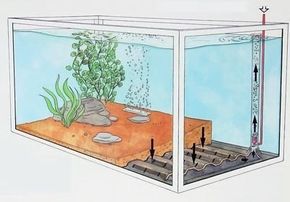Aquarium Filter Designs: Undergravel Filters
Biological aquarium filters, including undergravel filters, function in a completely different way, and they have a completely different design.
The Nitrosomonas and Nitrobacter bacteria necessary for biological filtration will colonize virtually every surface in a tank. However, there is usually not enough surface area in a tank to support populations of these nitrifying bacteria large enough to process all the ammonia that is produced in a typical aquarium.
Advertisement
A biological filter deals with this problem by making the natural nitrogen cycle operate more productively.
A biological filter has two main functions. It increases the amount of surface area available to the nitrifying bacteria, and it creates a constant flow of aquarium water over the colonized area.
The most popular kind of biological filter is the undergravel filter. It is relatively inexpensive, reliable, and very effective.
An undergravel filter is really just a plastic plate that covers the bottom of the aquarium. The plate has many small holes or slots in it. The exact physical appearance varies from one brand to another, but all work on exactly the same principle.
The undergravel filter plate is covered with aquarium gravel. Located at each back corner of the plate is a lift tube that extends from the plate to the top of the tank.
The aquarium water is drawn up the lift tube along with bubbles from an air stone at the bottom or by a small motor, called a powerhead, at the top. This pulls water from under the plate, which in turn draws water down through the gravel.
As the water passes across the grains of gravel, the nitrifying bacteria living there use the dissolved oxygen in the water to metabolize the ammonia and nitrite. The grains of gravel offer a huge total surface area for the bacteria to colonize, and the steady water movement ensures that enough oxygen will be available to support the large colonies.
As a result, the aquarium will house more than enough nitrifying bacteria to complete the nitrogen cycle, and the fish will have a healthy environment.
In addition to being a biological filter, the undergravel filter acts as a mechanical filter because it catches solids as they pass into the gravel bed.
Unfortunately, this actually works against the biological filtration process because as the spaces between the pieces of gravel fill with particles, the flow of oxygenated water past the bacteria is reduced. Over time, the effectiveness of the biological filtration is significantly impaired.
This problem can be solved by using a separate mechanical aquarium filter to remove many of the particles before they become buried in the gravel bed, and by cleaning the gravel when doing water changes.
An undergravel filter does not function as a chemical aquarium filter. Some undergravel filters are equipped with small cartridges of granular activated carbon that sit at the top of each lift tube, but these should be discarded for two reasons.
First, there isn't enough carbon in these cartridges to last more than a few days at the most. Second, these cartridges reduce the flow of water through the filter significantly.
Go to the next section to describe one last aquarium filter design, sponge filters.
